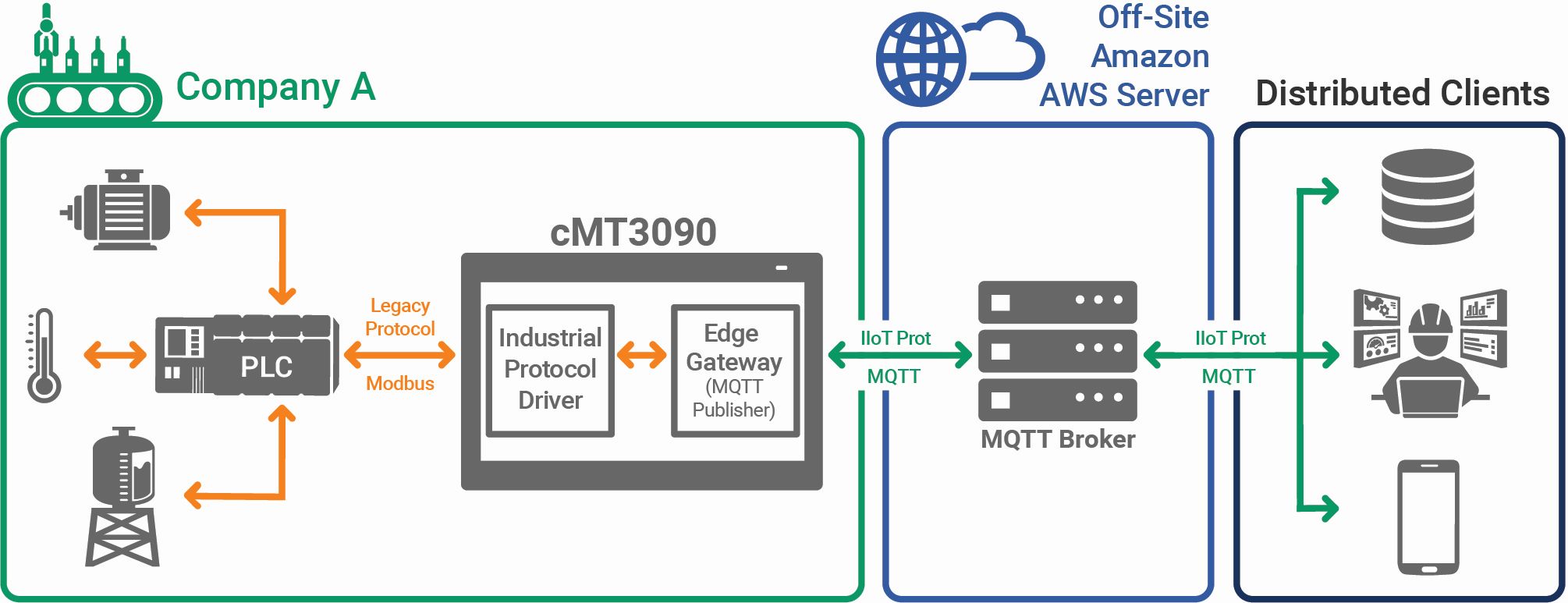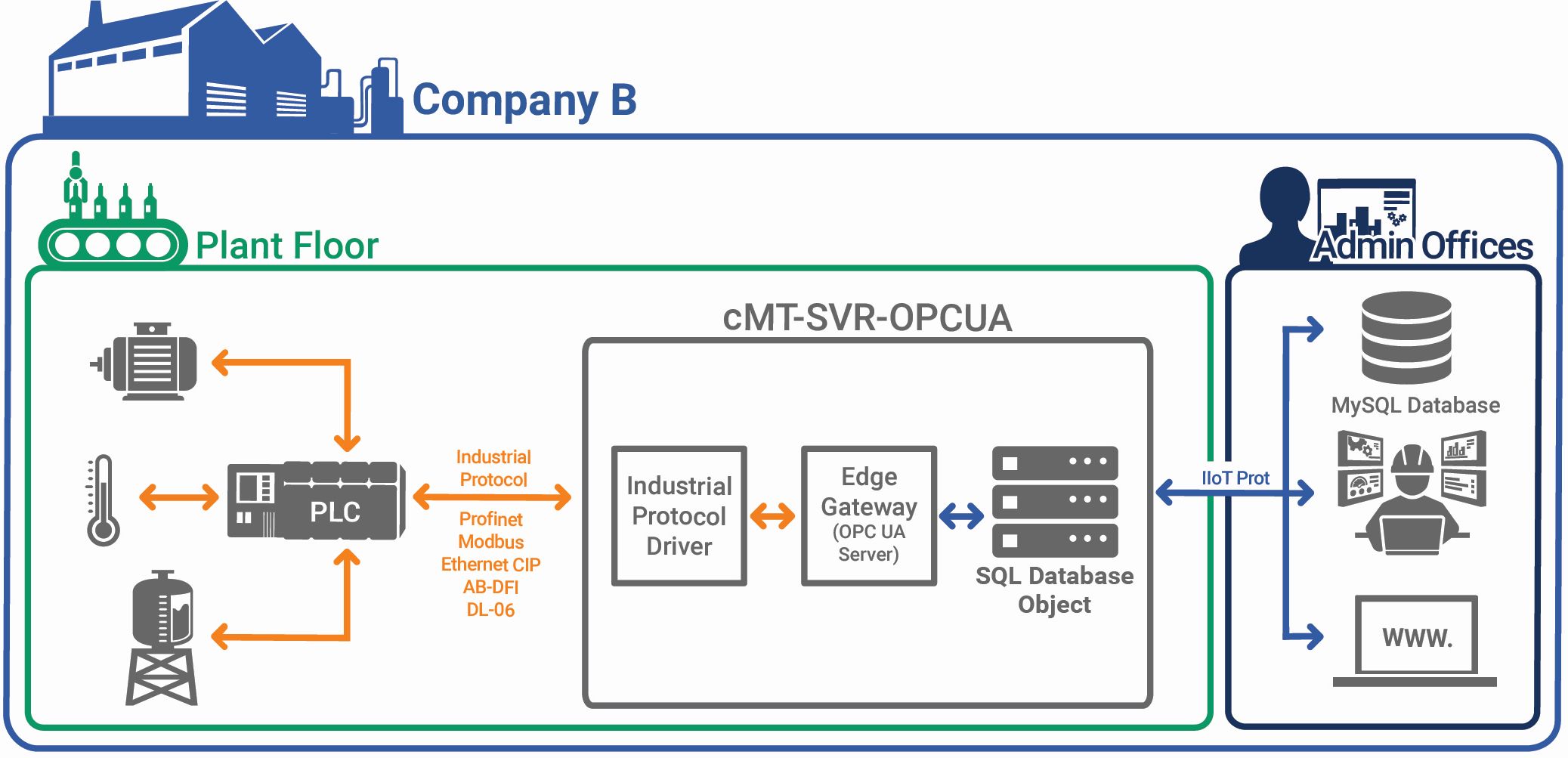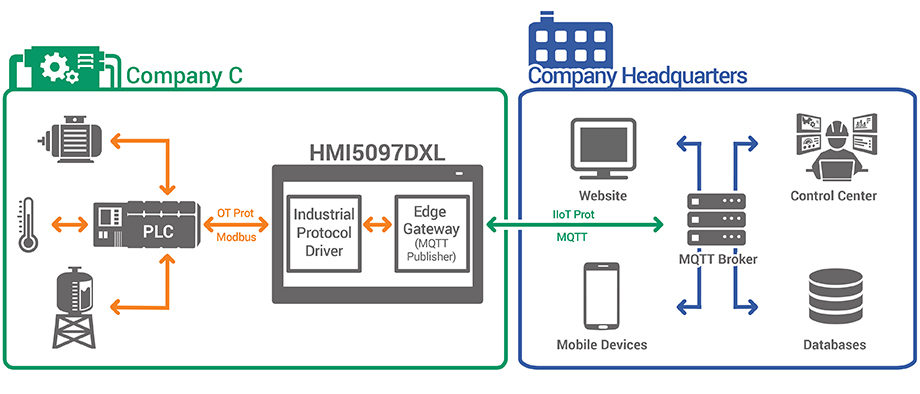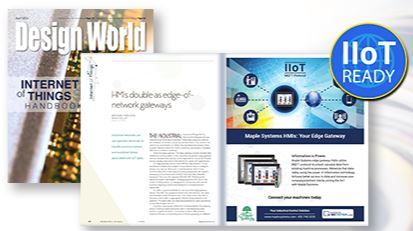IIoT Application Examples
Interested in the IIoT and ready to connect your factory/machines but are unsure of where to start? Maple Systems can help. This section details hypothetical users implementing IIoT solutions already available with Maple Systems products to get you thinking about how the IIoT can work for your unique business. Begin by implementing simple IIoT solutions today that will benefit your bottom line today, tomorrow, and well into the future.
Example 1: A Global Network
Company A feels the squeeze of market pressures. They need to stand apart from competition and increase profits. With global customers utilizing multiple machines per site, Company A wants to offer customers remote access/monitoring, remote functionality including email alarms, safely enable offsite troubleshooting and configuration, and reduce travel expenses and costly downtime. Company A realizes the IIoT is a great opportunity to differentiate their products.
EasyAccess 2.0 is chosen for secure remote access and its remote troubleshooting capabilities. The MQTT protocol is chosen for its extensive use and documentation with Facebook messenger, established cloud compatibility, and lightweight efficient nature for transporting large amounts of data across wide networks. MQTT also allows Company A to seamlessly expand their existing Amazon Web Services without hogging all available network bandwidth at each manufacturing site.
The company's engineering departments utilize many different PLC brands, all with different protocols. Machines are not able to easily communicate with each other. Thankfully, Maple Systems HMIs have excellent legacy protocol support, enabling data retrieval and conversion from a wide range of existing protocols, serving as a gateway to the IIoT.

Company A finds their solution in cMT3090 9.7" dual-Ethernet HMI, which serves as both an HMI and edge gateway. The cMT3090 supports the MQTT protocol and over 300 control protocols, enabling the linking of existing control networks with the IIoT. Dual-Ethernet ports offer functionality and security, separating operational technology networks inside the machine from external information technology networks that can be used for an EasyAccess 2.0 connection. This secure connection safely allows for advanced remote functionality such as email alarms, remote access, remote monitoring, and remote programming. As an OEM, dual-Ethernet HMIs allow Company A to maintain an isolated network dedicated to their machinery, yet still offer access to the Internet through their customer's ISP. The publish/subscribe architecture of the MQTT network and EasyAccess 2.0 VPN connection means they won't have to bug their customer's IT departments.
The cMT unit set up is simple and allows them to quickly and easily create control interface projects and take advantage of powerful IIoT features. Because their systems are widely distributed, Company A hosts their MQTT broker offsite with Amazon AWS. Their new data stream is connected to a web application that customers can log into for real-time machine monitoring.
EasyAccess 2.0 remote functionality built into the HMI allows Company A to update projects (including offsite MQTT setup) to meet changing customer demands without spending time and money onsite. The company is able to respond faster to software and data demands across their deployed equipment without ever leaving company headquarters. Company A utilizes predictive maintenance instead of preventative maintenance, enabling them to cut costs, improve troubleshooting, and decrease downtime. New machines added to their deployed network send smart data back to the central database for analysis. Sales overall increase because users feel the benefits of more data, accessible to more people.
For future machine builds, Company A will be able to proactively design units by analyzing data from their deployed equipment. Real-time data from deployed cMT3090 units will show how customers actually use their machines as well as highlight popular features used and those to be eliminated. This helps tailor future marketing efforts. Future machines will evolve according to specific data collected on how each feature is used, where the machine shines, and where it struggles.
Example 2: A Single Factory
Company B is a single-facility food processing company. Like many in the manufacturing industry their biggest obstacles for IIoT adoption are budget and interoperability. They have an existing SCADA package installation with OPC UA capabilities and a MySQL database.
Company B's factory has both Ethernet and serial control networks unable to share data due to incompatible protocols. The company wishes to centralize data without incurring additional costs for new server equipment and remote hosting. Key requirements for IIoT hardware include support for the OPC UA protocol, legacy protocol support, and secure remote functionality. The cMT-SVR-OPC UA is a perfect fit for Company B's needs since they do not require new displays. This unit is affordable with a small form factor which fits into existing panels.
Company B creates both a project with the necessary communications drivers and an OPC UA Server inside their new cMT-SVR-OPCUA. They define OPC UA tags to bring data from the plant floor into the informational environment, routing that information to dashboards and the SCADA software already in use by management. They also sync data logs to their centralized MySQL server for further analytics. Instead of relying on old data trickling into the system by manual entry, analytic software now offers a live data stream from operating machinery.
Remote access capabilities of the cMT-SVR-OPCUA dramatically change how Company B interacts with their system. The cMT-SVR-OPCUA connects to a laptop/PC or Android/iPad smart device with the free cMT Viewer application, freeing floor managers up to access/monitor machines from the palm of their hand. The email alarm feature alerts staff immediately when something runs amiss, delivering email alerts regardless of location. Dual-Ethernet ports plus serial communication offers a safe connection to office networks exposed to the Internet.

System awareness improves due to centralizing data from all facility machinery. Maintenance costs reduce thanks to linking machine wear data to usage data, improving machine use and extending machine life. By identifying data patterns that indicate likely failures, equipment life is extended, enabling machines to run to full life without risking costly shutdowns. By linking existing control hardware into a single database for access and analysis, Company B increases both the value and profit from data they were already collecting. Streamlined operation, predictive maintenance, and focused growth are achieved. For future machine additions, management will utilize detailed statistics on their highest profit machines and process bottlenecks. The versatile cMT-SVR-OPCUA can integrate with any vendor's machine and resource management system, meaning Company B will not be limited to using a single vendor. This will allow future growth targeted toward areas where the greatest impact will be achieved at the lowest cost.
Example 3: A Local Broker
Company C is a small local integrator utilizing a Systems as a Service business model. Company C wants to embrace advanced IIoT capabilities to amplify benefits they can offer customers, while reducing internal system maintenance and operational costs.
A recent review of a customer site found existing PLCs unable to communicate due to utilizing different proprietary protocols. The existing control system also had no external access due to strict IT department security requirements. In addition to the PLCs, sensors, and actuators required to control onsite equipment, their customer wants a local interface to monitor and control systems. Company C's current maintenance contract with the customer states that Company C must respond to major system faults within 4 hours.
Based on the above, Company C has the following interface requirements: Support for a wide range of protocols to connect existing controls, new system additions, and future expansions
- A secure connection to satisfy IT's security concerns and allow remote access
- MQTT protocol to connect to Company C's MQTT broker for system monitoring
- A very low rate of failure since Company C is obligated to cover warranty labor
- An easy configuration environment to facilitate the initial configuration and subsequent system updates and changes
Company C finds their solution in Maple Systems HMI5097DXL. The 9.7" graphical interface offers visual appeal to grab the operator's attention plus the new features Company C required. Because all Maple HMIs communicate with over 300 different PLCs, there's no need for additional gateways to connect older parts of the system or for future expansions. The HMI5097DXL's dual-Ethernet ports allow Company C to achieve remote access without compromising control system security. This means most service calls will be solved remotely, saving the expense of onsite visits. And because all Maple Advanced and cMT HMIs support MQTT protocol, Company C can deliver data safely and efficiently directly to their MQTT broker, providing real-time system oversight without spending a fortune to transmit excess data or license SCADA software.

Thanks to using past Maple products, Company C knows they'll receive a reliable product with no warranty issues. Maple's powerful and user-friendly configuration software gives Company C all the tools they need in an intuitive interface. Comprehensive online support and free Maple technical support leave Company C confident they can easily provide customers with the configuration, maintenance, and support they require.
Company C leverages modern IIoT control architecture to expand system oversight and maintenance offerings. Maintaining their own MQTT broker within their existing servers gives Company C access to data needed to monitor customer systems without incurring offsite storage costs. By collecting information from many similar control systems, Company C gains a significant systems awareness advantage. Company C even achieves higher-than-promised energy reductions thanks to tracking and analyzing multiple user data. When local operators implement system usage changes, pertinent data streams directly into the local MQTT server at Company C headquarters. The changes track for short-term impact, long-term output, and system maintenance. Data collected from the system also helps Company C anticipate problems before they arise, limiting expensive off-hour warranty calls. By implementing operational changes supported by factual data, Company C becomes an invaluable partner to their customer's bottom line.



